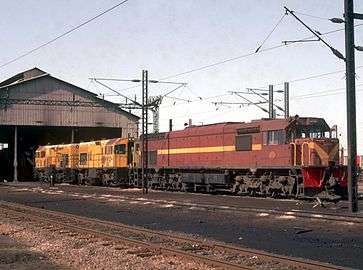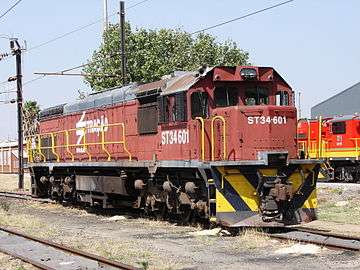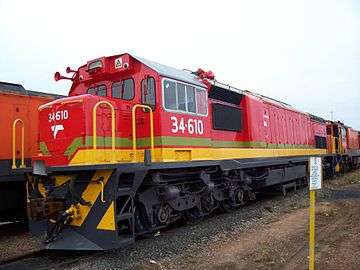South African Class 34-600
|
No. 34-612 on yard duty at Empangeni, Kwa-Zulu Natal, 14 August 2007 | |||||||||||||||||||||||||||||||||||||||||||||||||||||||||||||||||||||||||||||
| |||||||||||||||||||||||||||||||||||||||||||||||||||||||||||||||||||||||||||||
| |||||||||||||||||||||||||||||||||||||||||||||||||||||||||||||||||||||||||||||
| |||||||||||||||||||||||||||||||||||||||||||||||||||||||||||||||||||||||||||||
| |||||||||||||||||||||||||||||||||||||||||||||||||||||||||||||||||||||||||||||
The South African Railways Class 34-600 of 1974 is a diesel-electric locomotive.
Between December 1974 and July 1976, the South African Railways placed one hundred Class 34-600 General Motors Electro-Motive Division type GT26MC diesel-electric locomotives in service.[1]
Manufacturer
The Class 34-600 type GT26MC diesel-electric locomotive was designed by General Motors Electro-Motive Division and built for the South African Railways (SAR) by General Motors South Africa (GMSA) in Port Elizabeth. One hundred locomotives were delivered between December 1974 and July 1976, numbered in the range from 34-601 to 34-700.[1][2][3]
Class 34 series
_Number_Plate_(34-672).jpg)
The Class 34 locomotive family consists of seven series from two manufacturers, the General Electric (GE) Classes 34-000, 34-400, 34-500 (also known as 34-400 ex Iscor) and 34-900, and the General Motors Electro-Motive Division (GM-EMD) Classes 34-200, 34-600 and 34-800. Both manufacturers also produced locomotives for the South African Classes 33, 35 and 36.[1]
On the GM-EMD Class 34 series locomotives, the Class 34-200 and Class 34-600 locomotives are visually indistinguishable from one another, but they can be distinguished from the Class 34-800 by the thicker fishbelly shaped sills on their left sides, compared to the straight sill on the left side of the Class 34-800.[4][5]
Rebuilding and modification
Class 39-000
The South African Class 39-000 type GT26CU-3 diesel-electric locomotives were to be rebuilt from Class 34-600, 34-800 and 37-000 locomotives. The project commenced in 2005, using suitable frames from wrecked locomotives. Rebuilding was done at the Transwerk shops in Bloemfontein between 2006 and 2008.[2][6]
It was intended to produce one hundred Class 39-000 locomotives, but in spite of the technical success of the project, rebuilding was halted after completing the first five locomotives, due to higher than anticipated cost. It was decided, instead of rebuilding old locomotives, to continue the program by building fifty new Class 39-200 locomotives from imported and locally produced components. Three Class 34-600 locomotives, numbers 34-620, 34-635 and 34-674, were rebuilt to Class 39-000 before rebuilding was halted.[7]
Traction motor upgrade
In 2010, an upgrading project commenced at the Koedoespoort Transnet Rail Engineering shops, to upgrade Class 34-600 locomotives by, amongst other modifications, replacing the GM-EMD D29B with GM-EMD D31 traction motors, thereby improving their performance to the standard of the Class 37-000.[6] Locomotives which are known to have undergone this upgrade are annotated "D31 TM" in the "Leased, rebuilt or sold to" column in the table below.
Service
South African Railways
In SAR, Spoornet and Transnet Freight Rail (TFR) service, the Class 34-600s worked on most mainlines and some unelectrified branchlines in the central, eastern, northern and northeastern parts of South Africa.[3]
National Railways of Zimbabwe
From at least 1988 until at least 1992, the National Railways of Zimbabwe (NRZ) hired type GT26MC Class 34-600 locomotives from the SAR and later Spoornet. Locomotives which were observed to be working on the NRZ between April 1988 and September 1992, are annotated "NRZ" in the "Leased, rebuilt or sold to" column in the table below.[8]
NLPI Ltd.
NLPI Limited, abbreviated from New Limpopo Projects Investments, a Mauritius-registered company, specialises in private sector investments, using the build-operate-transfer (BOT) concept. It had three connected railway operations in Zimbabwe and Zambia, which formed a rail link between South Africa and the Democratic Republic of Congo.[2]
- The Beitbridge Bulawayo Railway (BBR), commissioned on 1 September 1999, operates the Beit Bridge to Bulawayo line in Zimbabwe.
- Since February 2004, NLPI Logistics (NLL or LOG) operates between Bulawayo and Victoria Falls on the Zimbabwe-Zambia border.
- Since February 2003, the Railway Systems of Zambia (RSZ) operated on the former Zambian Railways (ZR) from Victoria Falls to Sakania in the Congo.
In Zambia, the RSZ locomotive fleet included former ZR locomotives, but the rest of the locomotive fleet of all three operations consisted of South African GM-EMD Classes 34-200, 34-600 and 34-800 and GE Classes 35-000 and 35-400 locomotives from Spoornet and later TFR. These locomotives were sometimes marked or branded as either BBR or LOG or both, but their status, whether leased or loaned, was unclear, since they were still on the TFR roster and still often worked in South Africa as well.[2] Class 34-600 locomotives which served with NLPI include the locomotives annotated "NLPI" in the "Leased, rebuilt or sold to" column in the table below.
Zambia Railways, the state-owned holding company, resumed control of the Zambian national rail network on 11 September 2012. This followed the Zambian government’s decision to revoke the operating concession awarded to RSZ, after Finance Minister Alexander Chikwanda claimed that RSZ had "blatantly disregarded the provisions of the agreement" and had been "acting in a manner prejudicial to the interests of Zambians”.[9]
Sheltam
One of the Class 34-600 locomotives, no. 34-640, was sold to Sheltam, a locomotive hire and repair company, which undertakes complete operating contracts and maintenance contracts, based at the Douglas Colliery near Witbank in Mpumalanga. By the turn of the millennium, Sheltam locomotives were operating at Randfontein Estates Gold Mine in Gauteng, in Mpumalanga at Douglas and Vandyksdrift Collieries and at SAPPI, Ngodwana. They also operated on Spoornet’s Newcastle-Utrecht branch in KwaZulu-Natal and on Kei Rail in the Eastern Cape. Outside South Africa, they operated on the BBR, NLL and RSZ lines through Zimbabwe and Zambia, and in the Congo.[2][10]
Chemin de Fer Congo-Ocean
Six Class 34-600 locomotives were leased to the Congolese railway, the Chemin de Fer Congo-Ocean (CFCO), where they were renumbered in the range from CC801 to CC806.[2]
Camrail
Six more locomotives, which were at one time erroneously believed to have also gone to CFCO in the Congo, are now believed to have gone to Camrail in the Republic of Cameroon in about 2002, where they were renumbered in the range from CC2601 to CC2606. The order of their renumbering is not known.[8]
Ferrovia Centro Atlântico
Five Class 34-600 locomotives went to Ferrovia Centro Atlântico (FCA) at Divinipolis in Brazil, where they run on 1,000 mm (3 ft 3 3⁄8 in) . While they were initially part of Spoornet Traction’s leasing scheme, they were later renumbered onto the FCA roster, in the number range from 8226 to 8230.[2]
Ferrovia Sul Atlântico
Ten Class 34-600 locomotives went to Ferrovia Sul Atlântico (FSA) at Curitiba in Brazil, where they also run on Metre gauge. While they were also initially part of Spoornet Traction’s leasing scheme, they were later renumbered onto the FSA roster, in the number range from 8231 to 8240.[2]
Works numbers
The builder’s works numbers of Class 34-600 locomotives, as well as their known disposal and deployment, are listed in the table.[2]
Loco no. |
GMSA works no. |
Leased, rebuilt or sold to |
New no. |
|---|---|---|---|
| 34-601 | 101-1 | ||
| 34-602 | 101-2 | ||
| 34-603 | 101-3 | ||
| 34-604 | 101-4 | FCA | 8226 |
| 34-605 | 101-5 | ||
| 34-606 | 101-6 | NRZ | |
| 34-607 | 101-7 | ||
| 34-608 | 101-8 | ||
| 34-609 | 101-9 | ||
| 34-610 | 101-10 | ||
| 34-611 | 101-11 | ||
| 34-612 | 101-12 | ||
| 34-613 | 101-13 | ||
| 34-614 | 101-14 | ||
| 34-615 | 101-15 | ||
| 34-616 | 101-16 | ||
| 34-617 | 101-17 | ||
| 34-618 | 101-18 | FSA | 8231 |
| 34-619 | 101-19 | Camrail | |
| 34-620 | 101-20 | Class 39-000 | 39-004 |
| 34-621 | 101-21 | NRZ | |
| 34-622 | 101-22 | ||
| 34-623 | 101-23 | NLPI | |
| 34-624 | 101-24 | ||
| 34-625 | 101-25 | NRZ | |
| 34-626 | 101-26 | ||
| 34-627 | 101-27 | ||
| 34-628 | 101-28 | FSA | 8232 |
| 34-629 | 101-29 | ||
| 34-630 | 101-30 | FSA | 8233 |
| 34-631 | 101-31 | ||
| 34-632 | 101-32 | FCA | 8228 |
| 34-633 | 101-33 | ||
| 34-634 | 101-34 | ||
| 34-635 | 101-35 | Class 39-000 | 39-001 |
| 34-636 | 101-36 | ||
| 34-637 | 101-37 | ||
| 34-638 | 101-38 | ||
| 34-639 | 101-39 | ||
| 34-640 | 101-40 | Sheltam | 18/2604 |
| 34-641 | 101-41 | NLPI | |
| 34-642 | 101-42 | ||
| 34-643 | 101-43 | ||
| 34-644 | 101-44 | NRZ/Camrail | |
| 34-645 | 101-45 | ||
| 34-646 | 101-46 | FSA | 8234 |
| 34-647 | 101-47 | NLPI/D31 TM | |
| 34-648 | 101-48 | NRZ/NLPI | |
| 34-649 | 101-49 | ||
| 34-650 | 101-50 | NLPI | |
| 34-651 | 101-51 | ||
| 34-652 | 101-52 | ||
| 34-653 | 101-53 | ||
| 34-654 | 101-54 | ||
| 34-655 | 101-55 | Camrail | |
| 34-656 | 101-56 | FSA | 8235 |
| 34-657 | 101-57 | FSA | 8236 |
| 34-658 | 101-58 | ||
| 34-659 | 101-59 | FCA | 8229 |
| 34-660 | 101-60 | NRZ/Camrail | |
| 34-661 | 101-61 | NRZ/Camrail | |
| 34-662 | 101-62 | CFCO | CC804 |
| 34-663 | 101-63 | CFCO | CC805 |
| 34-664 | 101-64 | ||
| 34-665 | 101-65 | ||
| 34-666 | 101-66 | NLPI | |
| 34-667 | 101-67 | ||
| 34-668 | 101-68 | NRZ/NLPI/D31 TM | |
| 34-669 | 101-69 | FSA | 8237 |
| 34-670 | 101-70 | CFCO | CC806 |
| 34-671 | 101-71 | CFCO | CC803 |
| 34-672 | 101-72 | ||
| 34-673 | 101-73 | FSA | 8238 |
| 34-674 | 101-74 | NRZ/Class 39-000 | 39-003 |
| 34-675 | 101-75 | ||
| 34-676 | 101-76 | NRZ | |
| 34-677 | 101-77 | FSA | 8239 |
| 34-678 | 101-78 | NLPI | |
| 34-679 | 101-79 | ||
| 34-680 | 101-80 | NRZ/CFCO | CC801 |
| 34-681 | 101-81 | NRZ | |
| 34-682 | 101-82 | NRZ/CFCO | CC802 |
| 34-683 | 101-83 | FCA | 8227 |
| 34-684 | 101-84 | Camrail | |
| 34-685 | 101-85 | ||
| 34-686 | 101-86 | NRZ/D31 TM | |
| 34-687 | 101-87 | ||
| 34-688 | 101-88 | FCA | 8230 |
| 34-689 | 101-89 | ||
| 34-690 | 101-90 | NRZ | |
| 34-691 | 101-91 | NLPI | |
| 34-692 | 101-92 | FSA | 8240 |
| 34-693 | 101-93 | NLPI | |
| 34-694 | 101-94 | NLPI | |
| 34-695 | 101-95 | ||
| 34-696 | 101-96 | NRZ/NLPI | |
| 34-697 | 101-97 | ||
| 34-698 | 101-98 | NLPI | |
| 34-699 | 101-99 | ||
| 34-700 | 101-100 | ||
The Blue Train
In the SAR and Spoornet eras, when the official liveries were Gulf Red and whiskers for the SAR, and initially orange and later maroon for Spoornet, many selected electric locomotives and some diesel-electrics were painted blue, for use with the Blue Train, but without altering the layout of the various paint schemes. Blue Train locomotives were therefore blue with yellow whiskers in the SAR era, blue with the Spoornet logo and "SPOORNET" in Spoornet’s orange era, and blue with the Spoornet logo, but without "SPOORNET", in Spoornet’s maroon era. In Spoornet’s blue era, there was no need for a separate Blue Train livery, while in the Transnet Freight Rail (TFR) era, one Class 14E and the surviving Class 14E1 electric locomotives were eventually repainted in blue during 2012, for use with the Blue Train.[2]
Two known Class 34-600 locomotives, numbers 34-651 and 34-652, were painted in Spoornet’s orange era Blue Train livery.
Illustration
Depicted below is no. 34-652 in Spoornet’s Blue Train livery, incorrectly numbered as a Class 84-000 on the cabside. The error was corrected later. Other liveries which were applied to Class 34-600 locomotives, are also illustrated.[11]

- Blue Train no. 34-652 at Capital Park, 2 October 2006, incorrectly numbered 84-652
- No. 34-694 in Spoornet orange with NLPI LOG emblems, Capital Park, 10 May 2013
- No. 34-650 in Spoornet maroon with NLPI LOG emblems, Capital Park, 6 May 2013
 No. 34-601 with TRAÇÃO markings for Brazil, Pyramid South, 22 September 2015
No. 34-601 with TRAÇÃO markings for Brazil, Pyramid South, 22 September 2015 No. 34-610 in Transnet Freight Rail livery, Koedoespoort, Pretoria, 20 May 2011
No. 34-610 in Transnet Freight Rail livery, Koedoespoort, Pretoria, 20 May 2011
References
- 1 2 3 South African Railways Index and Diagrams Electric and Diesel Locomotives, 610mm and 1065mm Gauges, Ref LXD 14/1/100/20, 28 January 1975, as amended
- 1 2 3 4 5 6 7 8 9 10 Middleton, John N. (2002). Railways of Southern Africa Locomotive Guide - 2002 (as amended by Combined Amendment List 4, January 2009) (2nd, Dec 2002 ed.). Herts, England: Beyer-Garratt Publications. pp. 38, 41, 46–47.
- 1 2 Paxton, Leith; Bourne, David (1985). Locomotives of the South African Railways (1st ed.). Cape Town: Struik. p. 141. ISBN 0869772112.
- ↑ Class 34-600 sill
- ↑ Class 34-800 sill
- 1 2 Information supplied by staff at Transnet Rail Engineering, Bloemfontein and Koedoespoort
- ↑ The Class 39 Diesels
- 1 2 Spoornet Diesels Leased to ZR 1978-1993. P.F. Bagshawe.
- ↑ ZRL in charge as RSZ concession revoked. Railway Gazette International, 13 September 2012
- ↑ SA Rail, Volume 46, Number 2, April 2008, p3-7, ISSN 1026-3195
- ↑ Class 34-651 livery
| Wikimedia Commons has media related to South African Class 34-600. |
